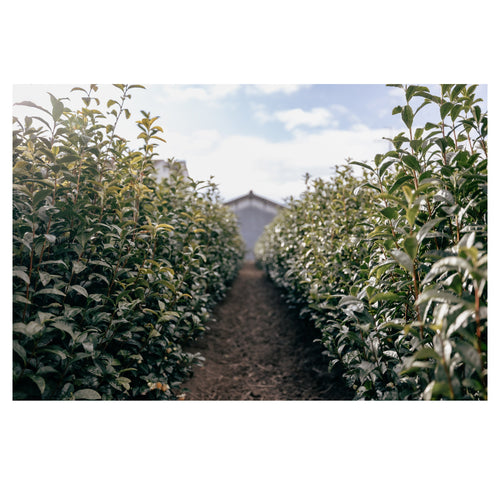A Tea Lover's Guide To Uji

Where to Stay – Uji Tea Inn (宇治・茶宿)

While the shops near Uji Bridge are fun for a quick stop, staying on the west side of town offers the chance for unstructured wandering and quiet discovery — and there’s much to explore. The Uji Tea Inn sits in a remarkable area where residential homes, matcha shops, and tea fields seem to blur together. It’s easy to turn a corner and find a field planted centuries ago. After noticing a marker for Yoshida Meichaen tucked among the rows of tea plants, I followed the narrow streets to their shop and left with a can of their matcha, harvested just steps away.

The Uji Tea Inn places you at the center of this unique neighborhood. With a shared kitchen and communal dining area, it feels more like a welcoming home than a traditional hotel. The highlight? Spacious rooms where you’ll sleep on soft tatami mats, right on the floor. Located near the Nintendo Museum and Ogura Station, it’s the perfect base for exploring Uji at your own pace.
Most Interesting Place to Drink – Matcha Roastery (抹茶ロースタリー)
Matcha Roastery pushes the boundaries of matcha with a process I've rarely seen anywhere else: roasting matcha powder itself — at multiple intensities. Here, you can order a tasting flight showcasing light, medium, and dark roast matcha, each with its own distinct character. 
The dark roast, in particular, reminded me of hojicha powder but with a noticeably brighter, more delicate finish. Unlike hojicha, which is roasted as whole leaves before milling, this matcha is roasted after being ground, creating a flavor experience that surprised me. This spot offers a tasting like no other for those curious about how far matcha can be pushed as a category.

Matcha Roastery recommends preparing it at room temperature to let the flavors fully express themselves. I followed their advice, sipping from the lightest roast to the darkest, and the differences were striking. Unfortunately, the tasting flights are strictly for two—no solo servings here. So, if you show up alone, brace yourself for a serious buzz from the double dose.
Where to Buy Teaware - Asahiyaki Shop and Gallery (朝日焼)

Asahiyaki Shop and Gallery preserves a rare and fading tradition: wood-fired teaware crafted from local clay. As the staff explained during my visit, wood firing has become increasingly uncommon in Japan due to environmental regulations, with most artisans shifting to modern gas and electric kilns. However, the artists at Asahiyaki have special permission to continue this historical method, and the work featured in the shop is easily some of the most interesting and beautiful I have seen in Japan.

The studio specializes in Asahiyaki teaware, a tradition from Uji that dates back over 400 years. Each piece uses clay sourced from the surrounding landscape, including the Uji River that flows just outside the studio's walls.
Where to Buy Tea - Tsuen Tea (通圓本店)

Tsuen is the essential stop for any tea lover visiting Uji. Established in 1160, it is Japan's oldest continually operating teaseller. The current building dates back to the 1600s, though you wouldn't be able to tell from looking at it.

The staff here are warm, welcoming, and incredibly knowledgeable. Don’t hesitate to ask for recommendations — they’re happy to guide you through their collection. Just be specific when asking for help — you can save time if you are upfront about your interest in type (sencha, gyokuro, etc.) and origin (single-field teas versus blends).
Best Place to Learn About Tea - Uji Tea Museum (お茶と宇治のまち交流館 茶づな)

The Uji Tea Museum is filled with fascinating ephemera that traces the evolution of Uji's local tea culture. Though most of the displays are in Japanese, a quick pass with a translation app makes it easy to unlock the stories behind the displays. The museum is right by the train station, with an expansive courtyard featuring tea fields and a nice view of the landscape.

One of the most unique offerings here is their hands-on workshop, where you can grind tencha into matcha using a stone mill. Though I didn’t have time to try it myself, it seems like a great way to deepen your appreciation for the labor behind the leaf — something I’ll return for.
Unexpected Tea Foods - Cha Soba (茶そば)

Cha Soba is made from buckwheat flour, wheat flour, and matcha powder, giving it a pale green hue that radiates from the bowl. The matcha doesn’t overpower the flavor; the noodles pair beautifully with the brothy goodness.
I had the matcha soba at the eatery attached to Tsuen Tea House, and it was the perfect quiet moment in an otherwise busy day. Sitting by the window with a bowl of matcha and this bowl, I could gaze out over the river and recharge.
While Uji is full of matcha-themed foods — some more about novelty than taste — this dish felt honest and good. If you're looking for a tea/food pairing that's satisfying as well as scenic, this is it.
Hidden Gem – Matsusakaya (松阪屋嘉八 本店)

Matsusakaya feels unlike virtually every other tea shop I visited in Uji. The owners were warm and welcoming, inviting guests to sit down for a cup of their tea — an uncommon gesture in many Japanese tea shops, where the focus often leans more toward retail than hospitality.

Established in 1843, Matsusakaya is now run by the fourth generation of the founding family. The building is rich with old and unique decor, and space is extremely limited, so try to visit early for a quieter experience. Don’t miss the back wall display, where you can watch tencha being ground into matcha — a rare glimpse behind the curtain of Uji's most famous product.
